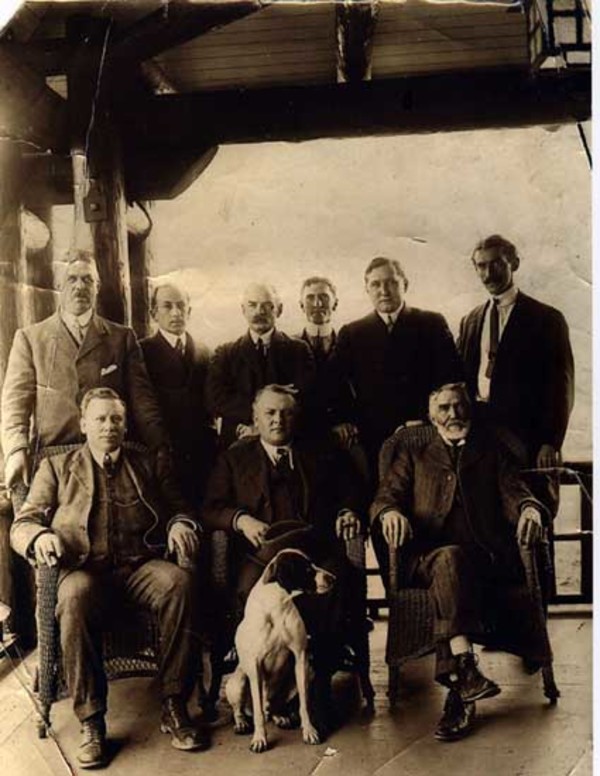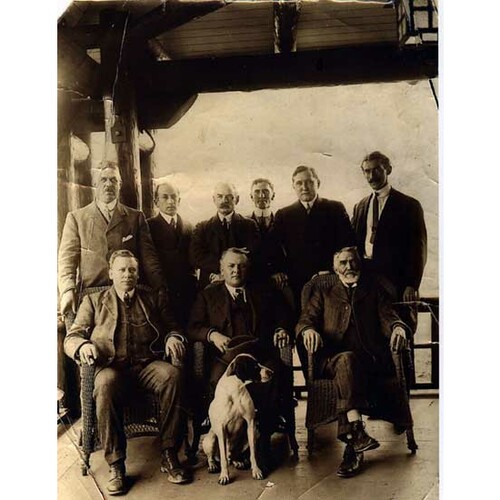
Source: Link
DOHERTY, CHARLES EDWARD, psychiatrist, asylum superintendent, and militia and army officer; b. 29 Nov. 1873 in Toronto Township, Ont., son of William Frederick Doherty and Anna Maria Henley; m. 1905 Elweena Martin, and they had at least two children; d. 14 Aug. 1920 in New Westminster, B.C.
Charles Doherty’s parents were successful pioneer farmers and major landowners in Peel County, Ont. When he was a boy, they moved to Eglinton (Toronto). It was likely their prosperity that enabled him to pursue a higher education, first at the Toronto Collegiate Institute and later at Trinity Medical College. In 1899, at age 25, he received his md and cm.
Immediately following his graduation Doherty moved to British Columbia, where in 1900 he took up the post of superintendent at Kootenay Lake General Hospital in Nelson. In May 1902 he left the Kootenays to become assistant medical superintendent at the Public Hospital for the Insane in New Westminster. His first term of employment in the ranks of the provincial civil service was to be a short one: six months later he quit, an initial enthusiasm for the work being apparently overshadowed by the low financial remuneration. He became coroner at Ymir and unsuccessfully attempted to establish a viable private medical practice.
On 1 March 1905 Doherty returned to the bureaucracy when he was appointed medical superintendent of the hospital for the insane, to replace George Herbert Manchester, who had resigned. The next decade was one of considerable expansion for the institution. British Columbia’s mental health facilities benefited from provincial prosperity, with annual stipends from the government rising from $84,561 in 1904 to $357,710 in 1914. Doherty proved to be an able administrator and a clever operator within the realm of the emerging provincial civil service. Unlike most of his predecessors, he had an amicable relationship with his political and bureaucratic masters. Premier Richard McBride was a personal friend, and Provincial Secretary Henry Esson Young*, himself a physician, was a strong supporter of the development of mental health care.
Doherty worked hard to promote a positive and professional image of psychiatry and mental health facilities, no small task at an institution with a history of public mistrust and scandal [see Richard Irvine Bentley*]. Eugenicist reservations about the mental health of immigrants and their offspring expressed in his annual reports echoed arguments being made by local women’s groups and served to illustrate the way in which asylum policy was addressing contemporary public concerns. Doherty also gave talks to members of the local medical profession, inviting them to tour the asylum, and after the formation of the British Columbia Medical Association in 1909, he served on its executive for a number of years. In 1912, addressing the American Medico-Psychological Association in Atlantic City, N.J., he outlined an optimistic picture of developments in his field in British Columbia, including the construction of a new and improved residential facility, at Essondale in Port Coquitlam. Essondale, he reported, would be composed of a central administrative building, with acute, chronic, and other buildings grouped around it in a horseshoe. The buildings were to be fireproof and well ventilated, and would allow in the maximum amount of sunlight.
His presence at the meeting in Atlantic City indicates another facet of Doherty’s efforts to promote British Columbia’s mental health profession. He was the first asylum superintendent from the province to take a place in the international psychiatric community, attending meetings of the American group from 1906. Although Doherty did not himself pioneer advances in the field, he introduced new ideas about the treatment and study of mental illness into the provincial system, thereby bringing British Columbia into the mainstream of contemporary psychiatric practice. Under his administration two new kinds of treatment were begun at the provincial asylum, work treatment and hydrotherapy, and a pathological laboratory was established at Essondale. Work treatment during his time most often meant work on the institution’s farm for male patients and laundry work for female patients. This form of treatment, which was much more widely used than hydrotherapy, served the additional purpose of bringing in considerable revenue. Indeed, in 1910 $25,000 in patient-generated revenue was recorded, a quarter of the entire maintenance expenditure for that year.
In August 1913 Doherty joined the militia as a major in the 104th Regiment. When World War I broke out a year later, he quickly enlisted in the Canadian Army Medical Corps. Placed on the staff of No. 1 General Hospital, he proceeded with it to England in September 1914 and to France in May of the following year. After a month he was transferred back to England, where he became assistant director of medical services. He was promoted lieutenant-colonel on 5 Dec. 1916 and early in 1917 his “Valuable Services in connection with the war” were brought to the attention of the British secretary of state for war. Later that year he returned to Canada and was retained there to work with mentally ill veterans at Newmarket Military Hospital in Ontario. Treatment for these “shell-shocked” victims of trench warfare was curtailed both by ignorance within the Canadian psychiatric community and by an unwillingness on the part of the Canadian military establishment and the federal government to accept responsibility for this group of disabled veterans. Doherty left the army in June 1918 but was recalled to military duty in August and appointed to No.11 CAMC Depot in Victoria. He retained his position until officially demobilized in 1919. Subsequently, he was active on the executive of the Great War Veterans’ Association of Canada.
In 1920 an exhaustive survey of British Columbia’s mental health facilities was published in the Canadian Journal of Mental Hygiene. Although Doherty had returned to the province only a short while before the evaluation had taken place, this document can nevertheless be read as a contemporary testimony to his career. Overall, the report is congratulatory, mentioning in particular the two-year training courses for psychiatric nurses set up before the war, the enthusiasm the doctors showed for their work, and the excellent script and photographic records that were kept.
Charles Doherty died in 1920, at the age of 46, after suffering for some months with nephritis. His medical career had been essentially that of a bureaucrat and administrator. At this work he was extremely successful, forging positive links between the provincial asylum and the local medical hierarchy, the provincial government, and the international psychiatric community.
NA, RG 150, Acc. 1992–93/166. Trinity College Arch. (Toronto), 990-0053/072: f.67. Globe, 3 Jan. 1913. Toronto Daily Star, 17 Aug. 1920. Vancouver Sun, 15 Aug. 1920. Kenneth Cameron, No.1 Canadian General Hospital, 1914–1919 (Sackville, N.B., 1938). Can., Dept. of Militia and Defence, Militia list (Ottawa), 1914; July 1919. Canadian Journal of Mental Hygiene (Toronto), 2 (1920): 289–90. Megan Davies, “The patients’ world: British Columbia’s mental health facilities, 1910–1935” (ma thesis, Univ. of Waterloo, Ont., 1989). M.-E. Kelm, “A life apart: the experience of women and the asylum practice of Charles Doherty at British Columbia’s Provincial Hospital for the Insane, 1905–15,” Canadian Bull. of Medical Hist. (Waterloo), 11 (1994): 335–55; “Women and families in the asylum practice of Charles Edward Doherty at the Provincial Hospital for the Insane, 1905–1915” (ma thesis, Simon Fraser Univ., Burnaby, B.C., 1990). National Committee for Mental Hygiene, “Mental hygiene survey of the province of British Columbia,” Canadian Journal of Mental Hygiene, 2: 1–59. Scholefield and Howay, British Columbia.
Cite This Article
Megan J. Davies, “DOHERTY, CHARLES EDWARD,” in Dictionary of Canadian Biography, vol. 14, University of Toronto/Université Laval, 2003–, accessed December 19, 2025, https://www.biographi.ca/en/bio/doherty_charles_edward_14E.html.
The citation above shows the format for footnotes and endnotes according to the Chicago manual of style (16th edition). Information to be used in other citation formats:
| Permalink: | https://www.biographi.ca/en/bio/doherty_charles_edward_14E.html |
| Author of Article: | Megan J. Davies |
| Title of Article: | DOHERTY, CHARLES EDWARD |
| Publication Name: | Dictionary of Canadian Biography, vol. 14 |
| Publisher: | University of Toronto/Université Laval |
| Year of publication: | 1998 |
| Year of revision: | 1998 |
| Access Date: | December 19, 2025 |



